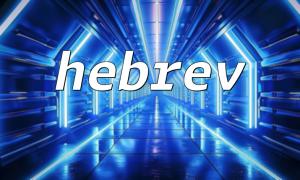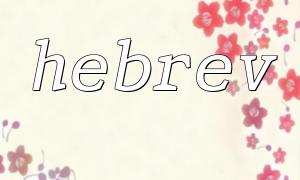When handling multilingual content, especially languages with different character sets and encoding standards, developers often face character escaping issues. Hebrew, as a right-to-left language, has unique encoding and display characteristics. To correctly display and handle Hebrew characters, developers need appropriate methods for encoding and escaping. In PHP, the hebrev and htmlentities functions provide highly effective solutions to ensure Hebrew characters display correctly on web pages.
The issues of escaping Hebrew characters mainly involve two aspects:
Character encoding issues: Hebrew uses "UTF-8" encoding, but in some cases, the character set may not be properly interpreted, causing garbled text.
Right-to-left writing: Hebrew is written from right to left, which may cause visual misalignment or formatting issues when rendered in HTML and CSS.
Therefore, correct character escaping is crucial. The hebrev and htmlentities functions in PHP can help solve these problems.
The hebrev function is a special PHP function used to handle Hebrew text. It converts a Hebrew string into a reversed string, allowing right-to-left characters to display in the correct order.
<span><span><span class="hljs-variable">$string</span></span><span> = </span><span><span class="hljs-string">"???? ????"</span></span><span>;
</span><span><span class="hljs-keyword">echo</span></span><span> </span><span><span class="hljs-title function_ invoke__">hebrev</span></span><span>(</span><span><span class="hljs-variable">$string</span></span><span>);
</span></span>Output: ???? ????
Although the hebrev function ensures characters display in the correct order, it does not handle HTML escaping. Therefore, it is sometimes necessary to use it in combination with other functions.
The htmlentities function converts special characters in a string to their corresponding HTML entities. For Hebrew characters, htmlentities ensures they display correctly on HTML pages without garbling or missing characters due to special character interpretation issues.
<span><span><span class="hljs-variable">$string</span></span><span> = </span><span><span class="hljs-string">"???? ????"</span></span><span>;
</span><span><span class="hljs-keyword">echo</span></span><span> </span><span><span class="hljs-title function_ invoke__">htmlentities</span></span><span>(</span><span><span class="hljs-variable">$string</span></span><span>, ENT_QUOTES, </span><span><span class="hljs-string">'UTF-8'</span></span><span>);
</span></span>Output: שויה ירוד
Using htmlentities, we convert Hebrew characters into corresponding HTML entities, avoiding potential garbling during direct rendering.
To handle Hebrew character escaping and encoding issues, we can combine hebrev and htmlentities to ensure characters display correctly and in the right order. The steps are as follows:
Use hebrev to adjust the order of Hebrew text.
Use htmlentities to convert characters to HTML entities for correct display on web pages.
Here is a sample code:
<span><span><span class="hljs-meta"><?php</span></span><span>
</span><span><span class="hljs-variable">$string</span></span><span> = </span><span><span class="hljs-string">"???? ????"</span></span><span>;
<p></span>// First, use hebrev to adjust Hebrew writing order<br>
$reversed_string = hebrev($string);</p>
<p>// Then, use htmlentities to escape Hebrew characters into HTML entities<br>
$encoded_string = htmlentities($reversed_string, ENT_QUOTES, 'UTF-8');</p>
<p>echo $encoded_string;<br>
?><br>
</span>Output: שויה ירוד
With this combined approach, developers can ensure Hebrew characters display correctly on HTML pages, with proper character order and correctly escaped special characters.
In addition to character escaping, Hebrew often encounters right-to-left formatting issues on web pages. To display right-to-left languages correctly, developers should set the appropriate HTML attributes. The following approach ensures proper Hebrew text display:
<span><span><span class="hljs-tag"><<span class="hljs-name">div</span></span></span><span> </span><span><span class="hljs-attr">style</span></span><span>=</span><span><span class="hljs-string">"direction: rtl;"</span></span><span>>
</span><span><span class="hljs-meta"><?php echo $encoded_string; ?></span></span><span>
</span><span><span class="hljs-tag"></<span class="hljs-name">div</span></span></span><span>>
</span></span>direction: rtl; ensures the text renders from right to left, maintaining correct Hebrew writing order and layout rules.
By combining hebrev and htmlentities, developers can easily resolve Hebrew character escaping and display issues. First, use hebrev to adjust Hebrew character order for correct right-to-left display; then, use htmlentities to convert characters into HTML entities, preventing garbled text due to encoding issues. Additionally, setting direction: rtl; ensures Hebrew displays in the correct right-to-left format.
This method is not only applicable to Hebrew but can also be used for other non-Latin characters requiring escaping, such as Arabic and Persian. With proper encoding and formatting, multilingual websites can correctly display and handle different language characters globally.





